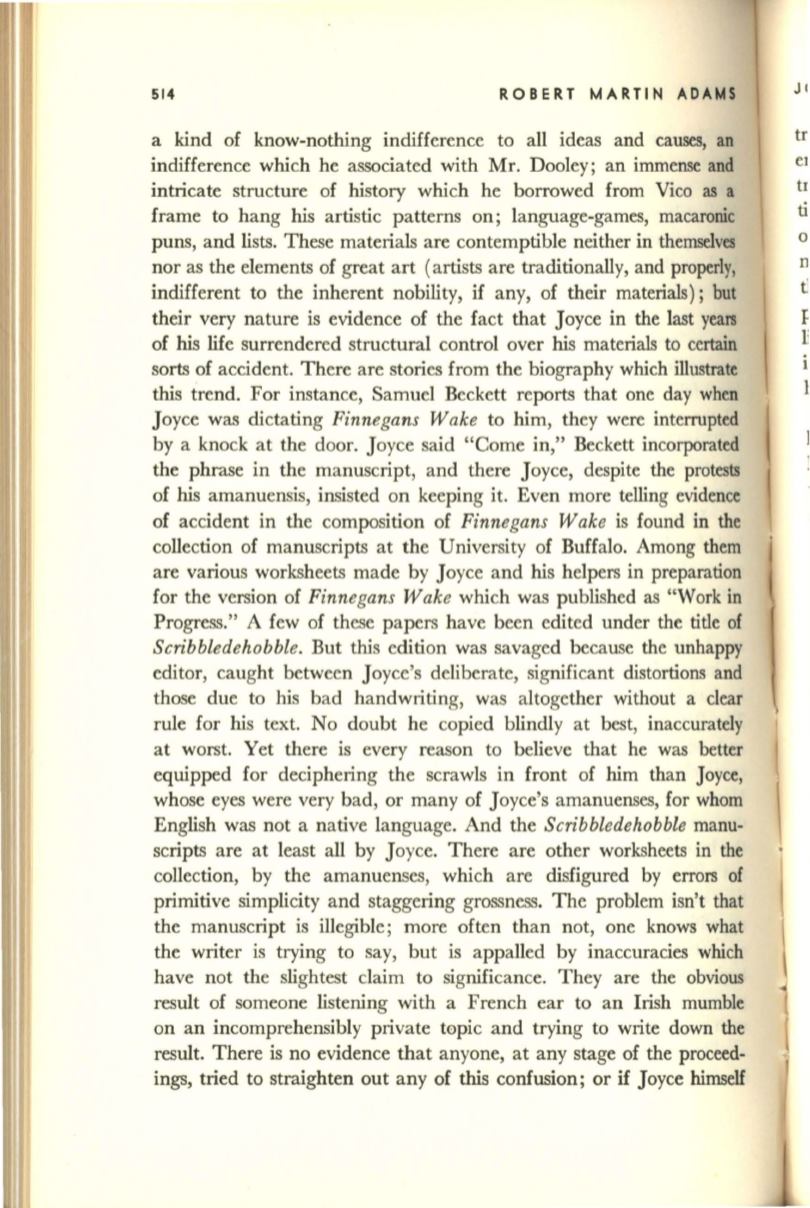
514
ROBERT MARTIN ADAMS
a kind of know-nothing indifference to all ideas and causes, an
indifference which he associated with Mr. Dooley; an immense and
intricate structure of history which he borrowed from Vico as a
frame to hang his artistic patterns on; language-games, macaronic
puns, and lists. These materials are contemptible neither in themselves
nor as the elements of great art (artists are traditionally, and properly,
indifferent to the inherent nobility, if any, of their materials); but
their very nature is evidence of the fact that Joyce in the last years
of
his
life surrendered structural control over his materials to certain
sorts of accident. There are stories from the biography which illustrate
this trend. For instance, Samuel Beckett reports that one day when
Joyce was dictating
Finnegans Wake
to him, they were interrupted
by a knock at the door. Joyce said "Come in," Beckett incorporated
the phrase in the manuscript, and there Joyce, despite the protests
of his amanuensis, insisted on keeping it. Even more telling evidence
of accident in the composition of
Finnegans Wake
is found in the
collection of manuscripts at the University of Buffalo. Among them
are various worksheets made by Joyce and his helpers in preparation
for the version of
Finnegans Wake
which was published as "Work in
Progress." A few of these papers have been edited under the title of
Scribbledehobble.
But this edition was savaged because the unhappy
editor, caught between Joyce's deliberate, significant distortions and
those due to his bad handwriting, was altogether without a clear
rule for his text. No doubt he copied blindly at best, inaccurately
at worst. Yet there is every reason to believe that he was better
equipped for deciphering the scrawls in front of him than Joyce,
whose eyes were very bad, or many of joyce's amanuenses, for whom
English was not a native language. And the
Scribbledehobble
manu–
scripts are at least all by Joyce. There are other worksheets in the
collection, by the amanuenses, which are disfigured by errors of
primitive simplicity and staggering grossness. The problem isn't that
the manuscript is illegible; more often than not, one knows what
the writer is trying to say, but is appalled by inaccuracies which
have not the slightest claim to significance. They are the obvious
result of someone listening with a French ear to an Irish mumble
on an incomprehensibly private topic and trying to write down the
result. There
is
no evidence that anyone, at any stage of the proceed–
ings, tried to straighten out any of this confusion; or
if
Joyce himself
J
I
tr
el
tr
ti
o
n
t


